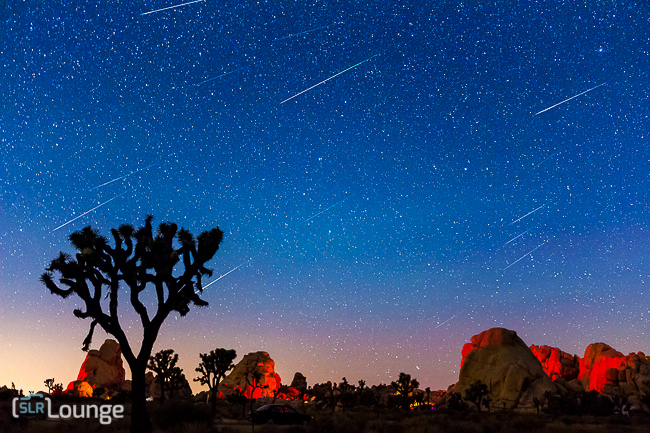Perseid Meteor Shower 2015
The Perseid Meteor Shower is here again, and this year, its peak will coincide with the blackest sky possible: a new moon! If you can find an area with clear weather, even just a few minutes outside city limits, you may see some exciting meteors.
The Perseids tend to peak late at night (early AM) on August 11th, 12th, and 13th. In a night sky without any light pollution, you might see as many as 100 “shooting stars” per hour, with dramatic “fireballs” here and there.
 Perseid Meteor Shower, 2013 | Canon 60D, Sigma 18-35mm f/1.8, Oben Tripod
Perseid Meteor Shower, 2013 | Canon 60D, Sigma 18-35mm f/1.8, Oben Tripod
So, grab your tripod and a remote trigger or intervalometer device, and watch this crash-course in how to best capture meteors!
How To Set Your Camera For Capturing a Meteor Shower
By the way, what happened to my timelapse? Well, clouds rolled in 10 minutes after I recorded this video. Go figure. Better luck tonight!
Critical Tips For Capturing Night Skies
1. Remember to set the interval of your camera’s timer to be slightly greater than the exposure time. A 30-second exposure usually requires intervals of 32-33 seconds. Alternately, if you have a Canon camera or a camera with an “unlimited shutter,” simply set your camera to 30 sec exposures, and then “jam” the shutter using a simple wired / wireless remote. Or even taping / rubber-banding a folded-up piece of paper onto your shutter, if you’re in a pinch.
2. Be sure to set your camera’s drive mode to continuous, and remember to turn off image playback, autofocus and stabilization features.
3. Turn down your camera LCD’s brightness as low as possible; it will help your night vision, and it will also help you avoid being fooled into underexposing your images.
4. Always check your histogram to confirm your exposure, when shooting in near or total darkness!
5. Remember that the infinity focus marking on your lens doesn’t always guarantee perfect star focus. Depending on your lens, and also depending on the ambient temperature, you may find that focus for stars is just to the left or right of infinity. On some lenses, a single millimeter on the focus ring can be the difference between sharp and soft stars!
6. Triple-check your focus, battery life, and memory card space before you click “go” and let the camera start running!
 Unfortunately, there are a lot of satellites and airplanes in the night sky as well.
Unfortunately, there are a lot of satellites and airplanes in the night sky as well.
Click here to watch a video about how to tell the difference!
Best Camera Gear and Settings for Meteor Shower and Astro-Landscape Photography
First and foremost, don’t feel overwhelmed if your camera is just a beginner model, and not an expensive full-frame system. Even a basic kit DSLR and zoom lens can do the trick! What is far more important is having a solid tripod, and some sort of interval timer device. Combine these tools with the right settings, and you’ll be very impressed with the results!
- Any recent or current digital camera body will do!
- A wide, fast lens, preferably f/1.4 or f/2.8, but f/3.5 will do in a pinch. Get at least 18mm for a crop-sensor, or at least 28mm for a full-frame sensor.
- A solid tripod. If your tripod is very lightweight, or very unstable, try weighing it down with something, or setting the legs at their lowest setting. Sometimes I even lay the legs flat and put rocks on top of the legs!
- A remote trigger. One that can do interval timing is preferred, but any trigger will do. Most Nikon cameras actually have a built-in intervalometer!
- Start at about 30 seconds, f/1.4 or f/2.8, and ISO 1600, 3200, or 6400. If you’re in a suburban area with lots of ambient light, you might need to darken your exposure a bit, maybe even go down to 15-second exposures. Or if you’re in the middle of nowhere, you might find yourself at the brightest of these settings, and maybe even use a 60-second exposure.
 Before
Before
 After
After
Click here for a tutorial on how to create a star trail from your 30 second exposures!
Additional Tips for Good Nightscape and Astro-Landscape Photography
Once you start your timelapse, stick around and listen for a couple of “clicks” to ensure that your camera keeps firing and isn’t skipping any shots
If you don’t have a battery grip or external power source, to get the longest possible recording time, remember to use a half-dead battery for all your test shots, and then switch out to a fresh, full battery right before you start your timelapse. (Be sure to double-check that it’s at 100% first!)
Don’t forget to check the batteries in your intervalometer, and carry a spare set of AAA batteries or whichever button-type battery your remote trigger needs.
Also, be sure to turn off image review/playback so that your camera LCD doesn’t come on for a second or two in between each frame.
If you’re out shooting with a handful of friends and you’re considering setting up a camera within the composition of another person’s camera, be sure to cover up any blinking lights on the back of your camera with a bit of tape, even if the camera is hidden from view.
Having trouble figuring out what to do with all these photos later, after you’ve captured them? We have lots of tutorials on blending night images together on our Youtube channel!
[Rewind: Get Ready for the 2014 Lyrid Meteor Shower!]
Oh, and as I learned the hard way, don’t forget to check the weather!
Take care, and good luck out there! If you have any additional questions or tips of your own, please comment below! I’ll look forward to seeing what folks capture in various parts of the world!
=Matt=













